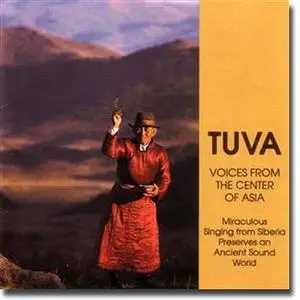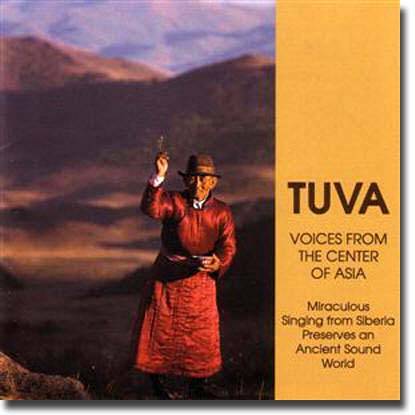Recorded in 1987, this highly-acclaimed release makes available to the world a miraculous and remarkable ancient musical tradition, including examples of the rare multiphonic "throat-singing" technique. Sponsored by the National Geographic Society, the Smithsonian Institution's Office of Folklife Programs, and the U.S.S.R. Union of Composers, it is an astonishing achievement. "Primal and forthright…a beguiling earful." — The New York Times
Barnes & Noble:
Until this disc of Tuvan throat singing and other local styles was published, the musical practices of this remote corner of Mongolia lying within the former Soviet Union remained a subject of fascination to the learned few. Ted Levin, a celebrated ethnomusicologist fluent in Russian and Turkic tongues, took part in an expedition with Soviet colleagues that resulted in this vital document of the incredible art of throat singing – the technique of achieving overtones, or split notes, with the voice. Glasnost allowed foreigners to enter previously inaccessible regions, and Levin and crew managed to tape important genres by outstanding performers. Their extensive booklet decodes the mysteries of this significant disc. Since its publication, once unimaginable visits by artists such as Huun Huur Tu have become annual events. While these artists have spread the country and eastern overtones of the cowboys of the Gobi Desert, this disc will remain an in-depth first entry into an unknown musical motherlode. Allan Evans
All Music Guide:
From the Smithsonian sound archives, this recording from 1987 features all of the various styles of Tuvan throat singing (khoomei), popularized to some degree in the West by groups such as Huun-Huur Tu and the movie Genghis Blues. The five styles are all given equal time: kargiraa, sigit, borbannadir, ezengileer, and khoomei. As would be expected by such an enterprise from the Smithsonian Folkways arm, the musicians are all excellent at what they do and perform their works beautifully. The main detractor on this album is the ridiculous shortness of every track, with the longest reaching up toward a minute and a half. Other compilations (Deep in the Heart of Tuva, Tuva: Among the Spirits) provide a better exposition of full songs, instead of simply the techniques in use. Still, for any budding ethnomusicologist this is a worthwhile one to pick up. For a newcomer, please note that khoomei is generally something of an acquired taste. One should definitely listen to some, but should do so with caution (wear your helmets, kiddies). Adam Greenberg
amazon.com comments:
This CD was one of the first to feature the unique musical tradition of Tuva. This CD was recorded in the yurts and natural areas of Tuva, so sometimes the sound quality isn't top notch. This is also more like a sampler. None of the tracks are very long and it moves through the different styles of throatsinging and melodies very fast. It does feature some of the revered masters of the styles though. I think this would be a good introductory disc to throatsinging, so a person can find what they like.
Tuva is a remote area smack in the center of Asia, nestled in the mountains between Siberia and Mongolia. Traditional Tuvan throat-singing is an amazing thing–the singer produces two notes AT THE SAME TIME, a low drone and a higher melody. This Smithsonian/Folkways CD was probably the first Tuvan CD available in the US; it was around when CD co-producer Ted Levin first brought three Tuvan throat-singers on an American tour. Unfortunately, the CD is primarily of ethnomusicological interest. There are brief examples of the various styles of khoomei (the general Tuvan name for throat-singing), but there are few tracks that can really be considered songs, and all but a few of the vocal tracks are a cappella. Only three of the 33 tracks on the CD are more than two minutes long. There is also plenty of jaw harp, animal imitations, a solo for hunting horn, and herders' calls to their flocks. If you're interested in hearing Tuvan MUSIC, you're better off with "Tuva: Voices from the Land of the Eagles", Ellipsis Arts' CD/book "Deep in the Heart of Tuva", or any CD by Huun-Huur-Tu.
This CD presents different styles of Xoomei, or throat singing, from an ethnomusicologist's perspective. It features some of the most incredible sounds on this Planet. It has been recorded in situ, so don't expect studio quality on each and every track. To my taste it's a great listening. Nonetheless, whoever is looking for "easy"-listening music featuring Xoomei, might find it a little dry, and may want to look for some records by Huun Huur Tu, Egschiglen or the like.
Tracklist:
1 Steppe Kargiraa - Fedor Tau
2 Sigit - Mergen Mongush
3 Sigit "Alash" - Mergen Mongush
4 Sigit with Igil (bowed instrument) - Anatolii Kuular
5 Khoomei - Fedor Tau
6 Khoomei - Sundukai Mongush
7 Tespeng Khoomei - Sundukai Mongush
8 Kozhamik (medley) with khoomei, sigit, and kargiraa - Tumat Kara-ool
9 Kargiraa duet "Artii-Sayir" - Tumat Kara-ool and Andrei Chuldum-ool
10 Khomuz melodies performed by trio of Khomuz players - Anchimaa Sonat, Anchimaa Khert, Achyimaa Targin Chandanmaa Torten-ool
11 Borbannadir - Mikhail Dopchun
12 Borbannadir - Tumat Kara-ool
13 Borbannadir with finger strokes across lips - Tumat Kara-ool
14 Borbannadir - Anatolii Kuular
15 Ezengileer - Marzhimal Ondar
16 Sigit with khomuz - Oleg Kuular
17 Medley of various throat-singing styles - Ensemble "Amirak"
18 Kargiraa "Artii-Sayir" - Vasili Chazir
19 Melody on the amirge (hunting horn): luring of the stag - Vasilii Khuurak
20 Imitation of the roe deer, the musk deer, the reindeer, owl, wolf's howl; Appeal to the patron of hunters before the bear hunt; Reindeer herder's calls to reindeer - Vasilii Khuurak, Shozhul Salchak, and Polina Ore-ool
21 Domestication of sheep to lamb - Doluma Lopsanchap
22 Domestication of goat to kid - Doluma Lopsanchap
23 Domestication of cow to calf - Khuren Oorzhak
24 Domestication of camel to calf - Shimet Soyan
25 Excerpt from shamanic healing ritual - Alexander Davakai
26 Funeral lament - Tatyana Sat
27 Lullaby - Tatyana Sat
28 Wooden jew's harp - Balgan Kuzhuget
29 Lullaby with Khoomei - Bilchit-Maa Davaa
30 Long Song: "Don't Frighten the Crane" - Sundukai Mongush
31 Long Song: "When I Graze My Beautiful Sheep" - Khuren Oorzhak
32 Kozhamiktar (antiphonal quatrains) - Group of men and women from Chadan, Dzun-Khemchik Region
33 Ceremonial Song: "Hymn to the Mountains" - Kazak Sandak



